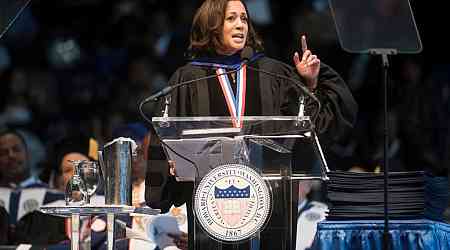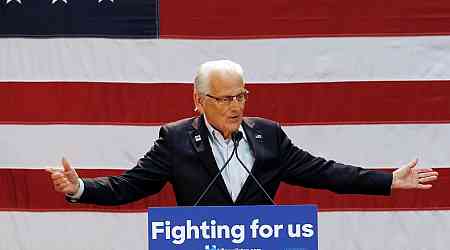
When she accepts her party’s presidential nomination on Thursday, Kamala Harris will become, among other historic firsts, the first Black woman and the first person of Asian descent to secure a major party’s nomination. But people often overlook that Harris is also the first nominee of either major party to graduate from a historically Black college or university (HBCU).
[time-brightcove not-tgx=”true”]As a proud alumna of Howard University, Harris is one in a long line of the school’s graduates to become a leader within the African American community—and in the nation as a whole. That’s not a coincidence. Howard’s motto is “truth and service,” and the school has long instilled a deep appreciation for public service in its students. This history and Howard’s commitment to nurturing community leaders helped attract Harris to the school.
Although its importance as an institution that produces civic leaders has often been overlooked outside of the African American community, some of the most eminent Americans graduated from Howard. The school’s story is a reminder that while the history books do not always reflect it, civic leadership in the U.S. has always been multiracial.
In 1867, Congress created Howard University as a racially integrated institution, named for Union general and head of the Freedmen’s Bureau Oliver Otis Howard—a white supporter of Reconstruction measures such as the 15th Amendment that granted freedmen the constitutional right to vote. The school’s founders—a combination of white Christian philanthropists and white politicians, including Howard—envisioned an institution that would train formerly enslaved Black Americans to become teachers, physicians, and ministers. When the school opened, the administrators and most of the faculty had similar backgrounds to its white founders.
While its mission was the education of Black Americans, upon opening, Howard “gained the distinction of being the first University in America to be established without some restriction based on race, sex, creed, or color.” It enrolled white students, especially white women, who were barred from attending many other coeducational colleges and universities. Howard Medical School, for example, graduated a large number of white women physicians when few other D.C. schools allowed them to attend. The first woman graduated from Howard Medical School in 1872—some 77 years before a woman graduated from Harvard Medical School.
Read More: The Long History of Black Collegiate Sororities Mobilizing Voters
Debates over Black education in the second half of the 19th century pitted advocates of “industrial” education, like Booker T. Washington, against proponents of “liberal” education like W.E.B. Du Bois. While many HBCUs emphasized vocational training over professional training, Howard fostered an ethos of Black leadership based on rigorous academic and professional training equivalent to elite, majority-white institutions. From its earliest days, the school pushed its students to choose high prestige careers that would serve the African American community. Some of Howard’s earliest graduates became luminaries in the Black community.
Mary Ann Shadd Cary, for example, was a prominent abolitionist and the first Black woman to publish a newspaper. In the 1880s she became the first Black woman to enroll at Howard, one of the first graduates of Howard Law School, and the second Black woman lawyer in the U.S.
Shadd Cary advocated for women’s suffrage. She wrote to the House Judiciary Committee to argue that under the 14th and 15th Amendments, Black women, as well as men, were citizens and thus endowed with the right to vote. Furthermore, she asserted that she was also a Washington, D.C., taxpayer and therefore entitled to the right and obligation of voting. Shadd Cary registered to vote in 1871, nearly 50 years before the passage of the 19th Amendment. She believed women’s rights included not only the vote but also the right to earn a living in a satisfying career.
Shadd Cary’s sister, Eunice Shadd, graduated from Howard Medical School and was among the first African American women physicians. The Shadd sisters were two of Howard’s most prominent 19th century alumni. Howard was unusual in admitting them to programs that granted degrees in law and medicine. But despite providing coeducational opportunities, women students comprised a small fraction of the graduates of these programs. Economic constraints and gender ideologies limited their enrollment.
By the early 20th century, most of Howard’s faculty were Black and the school had gained its reputation as a “Black Mecca.” The professors were intellectual leaders of their generation, and many of them came to Howard because of exclusionary hiring practices at majority-white schools. As Black leaders came to dominate the faculty and administration in an era of resurgent racial segregation and white supremacy, Howard’s significance grew.
In these years, Thurgood Marshall, who became the most famous graduate of Howard Law, enrolled. As the legal mastermind behind the dismantling of state-sponsored segregation, he served as counsel for the NAACP’s Legal Defense Fund in landmark civil rights cases, such as Brown v. Board of Education. He ultimately became the first Black Supreme Court justice. While best known for championing Black civil rights, Marshall’s jurisprudence on equal protection set the precedent for many other forms of civil protections, including LGBTQ rights.
Elijah Cummings, who earned his bachelor’s degree in political science from Howard in 1973, became another luminary and leader. Elected to the House of Representatives in 1996, Cummings became famous for his defense of voting rights. He also worked to lessen racial health disparities and strengthen veterans’ benefits.
From the Shadd sisters to Marshall to Cummings, each of these leaders strengthened and expanded democracy for all Americans. They took the Howard motto and the school’s emphasis on service to heart. As Howard’s reputation for producing community leaders grew, the school’s desire to inculcate academic rigor in service of others attracted students who wanted to use their knowledge and degrees to improve others’ lives.
Read More: ‘We Are Not Playing Around’: Harris Electrifies Room at Historically Black Sorority’s Conference
That included Harris. The Vice President matriculated to Howard in 1982, and from the time she was a prospective student, Harris recognized the heft and legacy of Howard’s history. She wanted to go to a university that would help her “get off on the right foot.” And she concluded, “What better place to do that than at Thurgood Marshall’s alma mater?”
Harris embraced Howard’s “expectation that we would cultivate and use our talents to take on roles of leadership and have an impact on other people, on our country, and maybe even on the world.” In the school’s vision, only then would students reach their full potential.
Harris describes Howard as “a place that shaped her” and her experiences as “formative” to her political career. Her fellow students were African Americans and students of African descent from throughout the African diaspora. During Harris’s four years at Howard, South African apartheid represented one of the most significant political issues on campus. Harris spent many weekends protesting it.
When it came time to choose a career, Harris followed the path of many of her university’s distinguished alumni and chose a career in law and politics, believing that representation could influence outcomes. She chose a career as a prosecutor in order to work on behalf of marginalized communities.
Her decision to pursue a political career as a fairly moderate Democrat reflected her longstanding desire—cultivated first at Howard—to work within institutions for structural change. Harris made this decision because her experiences at Howard taught her that “…there was an important role on the inside, sitting at the table where decisions were being made. When activists came marching and banging on the doors, I wanted to be on the inside to let them in.”

Stepping into the uncharted waters of replacing her party’s presidential candidate just 15 weeks before Election Day, Harris has captivated crowds eager to feel more hopeful about the future.
Whether her supporters know of Howard’s hallowed alumni or not, much of the exuberance around Harris’s candidacy lies in the hope that she will be a leader cut from the same cloth as these alumni who have come before her, leaders who worked to transform the nation’s future for all Americans in moments of uncertainty and turmoil. At a time when democracy itself could hang in the balance, Harris is aiming to follow in their footsteps.
Margaret Vigil-Fowler is a historian of medicine who studies the history of African American physicians. She is currently writing a book about a four-generation Black medical dynasty.
Made by History takes readers beyond the headlines with articles written and edited by professional historians. Learn more about Made by History at TIME here. Opinions expressed do not necessarily reflect the views of TIME editors.























